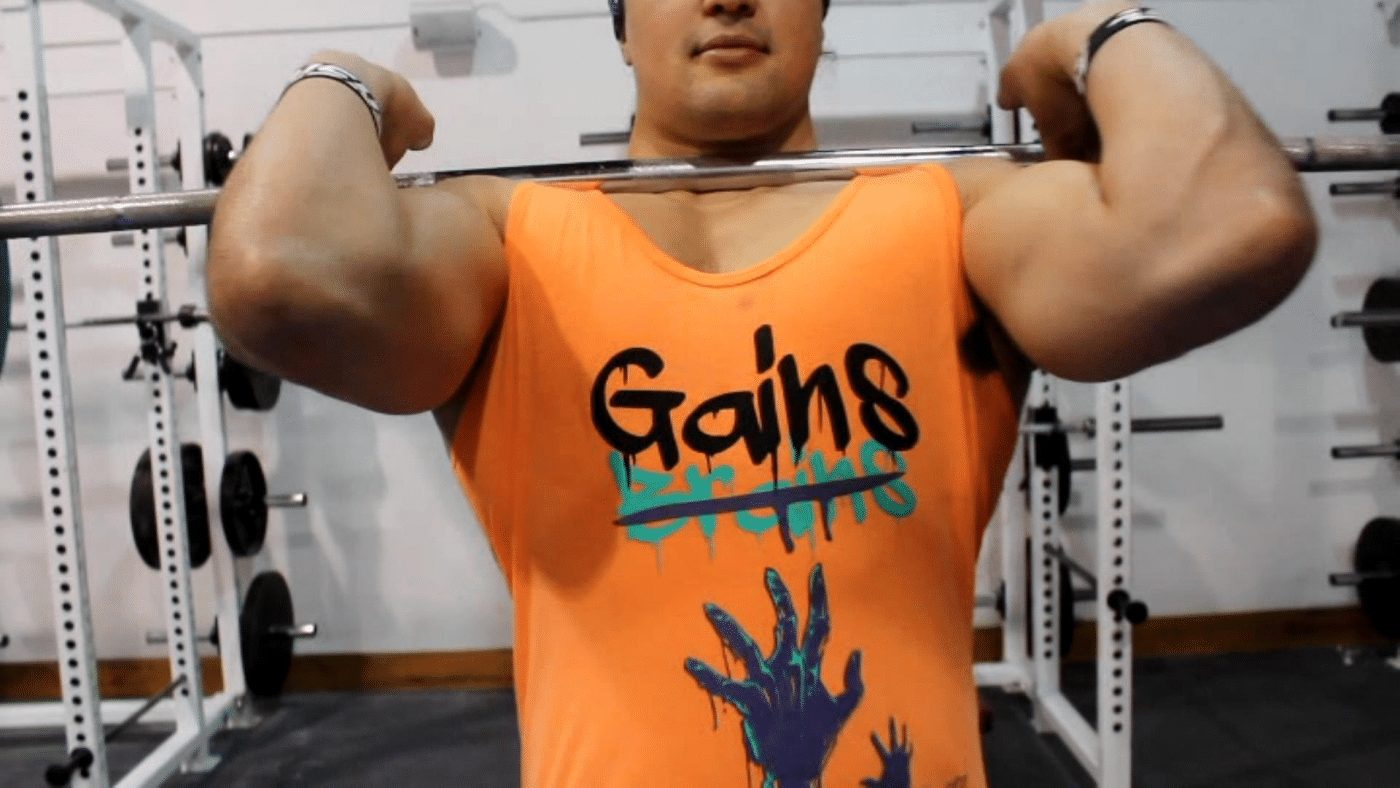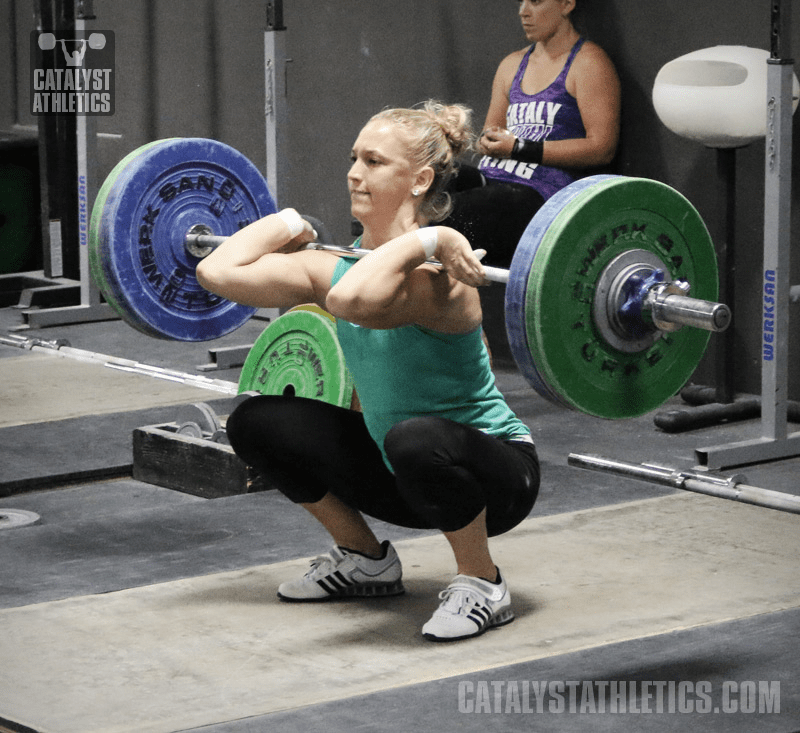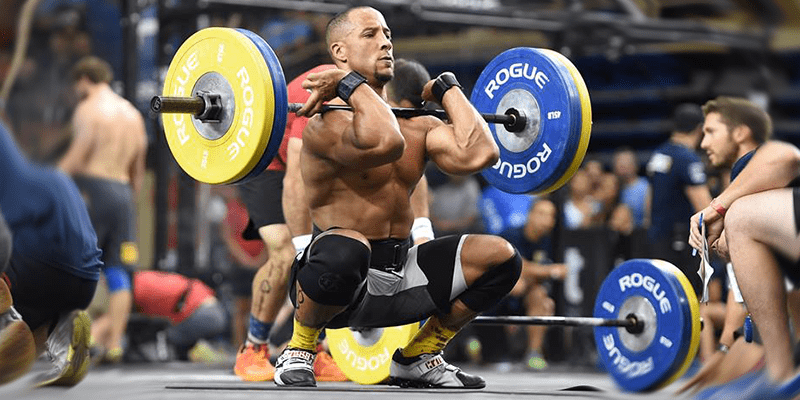The front rack position is necessary for CrossFit Athletes. It’s also a notoriously difficult and uncomfortable position for beginning athletes.
The mobility, body awareness, and willingness to learn a new skill that is necessary to be proficient with the front rack take a lot of practice.
But, it’s worth it. In CrossFit, you use the front rack position to perform front squats, cleans, jerks, and thrusters.
Many of the staple movements from the CrossFit Open are contingent on you learning how the front rack position.
In this guide, we’ll look at what the front rack position is, how to do it correctly, and then walk through 5 methods for improving your front rack mobility.
What Is The Front Rack Position?

In the front rack position, the bar rests on your clavicles and flexed shoulders.
The athlete must get comfortable with letting go of the bar in their hands in order to raise the elbows up high enough to establish the actual “rack” position.
Before the bar is taken out of the rack, the athlete should make their belly tight to prevent from leaning back and losing the position.
From the side, you can see the torso is vertical and the elbows are high, even at the bottom of a front squat.

Proper Front Rack Position
Here is a breakdown of the proper front rack position. Each section also offers coaching cues for you or your athletes.

Fingertips on the bar
The bar is not held in your hands in the front rack.
It’s loosely held by the fingertips and the weight is distributed across your body through your shoulders.
As a test, try getting into a front rack with elbows high without letting go of the bar.
You either won’t be able to, or it will be very uncomfortable.
Practice this by refusing to grip an empty barbell at all. Pass the elbows through, and let the bar rest on your three fingertips on each side until it feels comfortable.
Elbows High
In any movement using a front rack, your elbows must be in front of the bar and pointing forward.
Any lower and you lose the actual “rack” you’re trying to create to hold a load on the front of your body.
A good front rack position is completely different from proper overhead press technique.
Cue: “drive elbows to the ceiling”
Lats Engaged
Your elbows won’t stay high unless your lats are flexed and contributing to holding up the weight on the bar.
Think about keeping your lats tight and “spread” them out as wide as you can so that your shoulder joint is stable.
With your elbows up and the bar loosely gripped in your hands, flex your upper back muscles before removing the bar from the rack.
Cue: “spread your wings”
Tight Belly
Your torso must be vertical or the bar won’t be comfortable. Set up with a tight upper body and flexed abdominals. If you overextend, you’ll know. The bar will start choking you.
Cue: “tight belly” or “tack your ribs down”
Common Errors- Front Rack Position
Here are a few common errors that you may see or experience when learning the front rack.
#1. “Coach, this hurts my wrists”
If the pressure on your wrists is too much, you are either:
- Gripping the bar too tightly or not letting go of it in your hands, putting a ton of pressure on your wrists.
- Not mobile enough to get your elbows high in the front rack position.
Although the position is uncomfortable at first, most people have the mobility to get their elbows high enough. It’s likely that if your wrists hurt, your position looks something like this:

Fix: let go of the bar. Let it hang on 3 fingertips in your hand and rest on your collarbone and shoulders. Then, pass your elbows through, driving them to the ceiling.
#2. Leaning Forward/Leaning Back
Watch any CrossFit athlete perform a movement in the front rack.
Their torso is always vertical, which keeps the load evenly distributed across their body.

When learning the front rack, you’ll see athletes try to compensate for a lack of shoulder/wrist mobility by overextending and leaning back.
Fix: Overextension is often in conjunction with fault #1, so check how they (or you) are gripping the bar. Reset from the rack and try again standing tall.
Sometimes, it’s the opposite. The athlete doesn’t trust that the bar can rest on the shoulders/clavicles comfortable and tries to hold it lower, on the top part of the chest.
They won’t have a flexed back or belly, and the bar will be straining their wrists and shoulders.
Fix: Practice letting go of the bar and letting it rest on the shoulders with a lightweight. Take it out of the rack a few times without doing an exercise just to get a feel. Stand tall throughout.
4 Ways To Improve Front Rack Position
If you’re still struggling with the front rack, or want to bring new drills in for your athletes, check out these 4 videos for improving the position:
Front Rack Warm Up
For some of you, it might just be a matter of warming up to hit the right front rack position.
Stretching out the shoulders, triceps, and lats using a bench or a bar in the rack before you get started is a good way. This Part 1 video will give you some ideas:
Around 2:40, you’ll see her working through the upper body portion of the warm-up.
Mobility Drills
Mobility drills will help you if you’re confident that you simply don’t have the flexibility to achieve the front rack position. Use this MobilityWOD from Kelly Starrett:
This drill requires a partner, but will really help get you ready for high elbows and active lats. It’s being taught at a CrossFit L1 certification by CFHQ.
This is a great one to do before a workout or competition as it only requires a bar and a rack. Here’s a 3-minute mobility drill from CrossFit Element:
Conclusion
The front rack position is necessary for cleans, front squats, thrusters and jerks. This makes it an essential position to learn for all CrossFit athletes.
Though it can feel uncomfortable at first, the key to learning the position is to practice as much as you can.
Think about the keys to a good front squat: elbows high, letting the bar go in your hands, tight lats, and an engaged core.
Keep your torso vertical to ensure the load of the bar is distributed equally throughout your body. They are called compound movements for a reason!
If you’re really stuck or struggling, give some of the mobility and warm up videos a try.
Even 2-3 minutes a day of dedicated work will get you into a good front rack position in just a few days.

